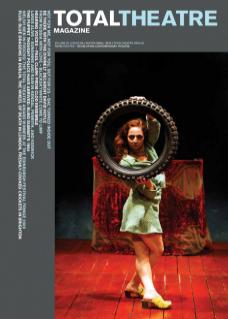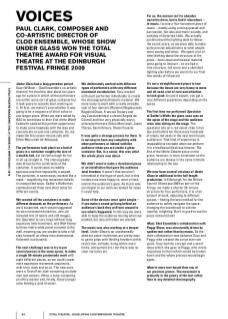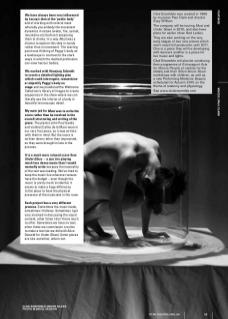Under Glass had a long gestation period. Suzy (Willson – Clod Ensemble’s co-artistic director) first had the idea about ten years ago for a piece in which all the performers are within some sort of glass container but it took years to actually start working on it. At first, we weren’t sure whether it was going to be a sequence of short solos or one longer piece. When we were asked by BAC to contribute to their End of the World Cabaret it seemed like perfect opportunity to make some headway with the idea and concentrate on just one container. So, we made the first seven-minute solo with Silvia Mercuriali (of Rotozaza).
The performance took place on a bed of grass in a container roughly the size of a double bed, but not tall enough for her to sit up straight in. The choreography was driven by the constraints of the container. It could seem incredibly spacious and then impossibly cramped. The container, in some ways, worked like a mask – magnifying tiny movement details in unexpected ways. Sadler’s Wells then commissioned three new short solos for different events.
We wanted all the containers to make different demands on the performers. As we’d suspected, each vessel suggested its own movement dynamics: Jam Jar revealed lots of twists and still images, the Spectator (a very large tall box) long expansive limb movement, and Wall Flower (a three-metre-wide panel screwed to the wall, meaning you are unable to take a full step forward) an almost two dimensional, flattened-out dynamic.
The next challenge was to try to put several pieces in the same space, to make a single 50-minute promenade work with eight different pieces, so we could create more expansive movement sequences, with trios, duos and so on. The new ones were a Twins Petri dish containing an older man and woman; Office, a cube containing an office worker and, finally, Flood a larger cube holding a pool of water.
We deliberately worked with different types of performers with very different movement vocabularies. Suzy worked with each performer individually to create the choreographic/dramatic material. We were lucky to work with a really enviable cast of four dancers (Ramona Nagabcynski, Ragnihld Olsen, Francois Testory and Joy Constantinides) a clown (Angela de Castro) and four very physically savvy actors/performers (Silvia Mercuriali, Jason Thorpe, Sachi Kimura, Olwen Fouere).
It was quite a strange process for them. It is not easy to have any complicity with other performers or indeed with the audience when you are inside a glass container. But, in a sense, this was what the whole piece was about.
We didn’t want to make a durational piece or an installation that gave the audience total freedom. It wasn’t that we aren’t interested in that type of work, but in this instance we were happy to, more or less, control the audience’s gaze. As music was so integral to our work we looked for ways it could help.
Some of the devices were quite simple – if you make a sound go bang behind an audience’s back they will turn around to see what’s happened. In this way we were able to keep the audience moving when we wanted, but also still when we wanted.
The music was also working at a deeper level. Under Glass is an unashamedly abstract piece: its themes are pretty easy to get to grips with (finding freedom within restriction, solitude, living within one’s limits, entrapment etc.) but there was no clear narrative arc.
For us, the answer isn’t to abandon narrative drive, but to find it elsewhere – in music. I wrote a five-movement piece of music – mostly using a string quartet and percussion, but also electronic sounds, and samples of distorted radio. We actually synchronised the lighting desk to follow the sound score, so we were able to make quite precise adjustments to what people were seeing and when. We spent a lot of time thinking about the structure of the piece – how visual and musical material were going to interact – so we had a firm structure, full score and a sketched lighting plan before we went into our final few weeks of rehearsal.
It’s not a straightforward piece to tour because the boxes are very heavy to move and all need a lot of care and attention to look good. As you’d expect, you get a very different experience depending on the space.
The first time we performed Spectator at Sadler’s Wells the glass case was on the apron of the stage and the audience were also sitting on the stage. The spectator sits on a red velvet chair in her box and behind her there were hundreds of empty red seats in the vast main house auditorium. That kind of experience is impossible to recreate when we perform it in a traditional black box theatre. The End of the World Cabaret piece on the grass, however, is more consistent as the audience are always in the same intimate relationship to the box.
We now have several versions of Under Glass in additional to the full-length production. In Edinburgh, for the British Council Showcase 2009 as part of the Fringe, we made a shorter 20-minute structure for four performers. It is a fair amount of work, adjusting to different spaces – finding the best method for the audience to safely navigate the space, changing the soundtrack to suit the room(s), relighting. But it is good to see the piece reinvent itself.
Must, Clod Ensemble’s collaboration with Peggy Shaw, was structurally driven by spoken text rather than by music. So the main collaboration was between Suzy and Peggy who created the script over two years. Suzy had the concept and a set of ideas which she gave to Peggy, who wrote responses to them which would be broken down and the whole process would begin again…
Must is more text-based than any of our previous pieces. The movement is primarily in the poetry of the text rather than in any detailed choreography.
We have always been very influenced by Lecoq’s idea of the ‘poetic body’ and of working with neutral mask whereby you embody the movement dynamics in nature (water, fire, sunset, mountains etc) before transposing them to drama. In a way Must was a chance to explore this idea in words rather than in movement. The starting point was thinking of Peggy’s body as a landscape in contrast to the stark ways in which the medical profession can view her/our bodies.
We worked with Hansjorg Schmidt to create a detailed lighting plan which could interrogate, romanticise or objectify Peggy’s body on stage and we plundered the Wellcome Collection’s library of images to create sequences in the show where we can literally see the interior of a body in beautiful microscopic detail.
My main job for Must was to write the score rather than be involved in the overall structuring and writing of the piece. The pianist John Paul Gandy and violinist Calina de la Mare were in our very first piece, so it was written with them in mind. But the score is written down rather than improvised, so they were brought in late in the process.
It is a much more relaxed score than Under Glass – a jazz trio playing much less dense music than I would normally write because the musicality of the text was leading. We’ve tried to keep the music live wherever venues have the budget – even though the music is pretty much incidental, it seems to make a huge difference to the piece to have the physical presence of the musicians in the room.
Each project has a very different process. Sometimes the music leads, sometimes it follows. Sometimes I get very involved in discussing the visual content, other times I don’t have much to offer. Sometimes we have no text; other times we commission a writer to make a text (as we did with Alice Oswald for Under Glass). Some pieces are site-sensitive, others not.
Clod Ensemble was created in 1996 by musician Paul Clark and director Suzy Willson.
The company will be touring Must and Under Glass in 2010, and also have plans for earlier show Red Ladies.
They are also working on the very early stages of two new pieces which won’t reach full production until 2011. One is a piece they will be developing with dancers another is a piece for live music and lights.
Clod Ensemble will also be continuing their programme of Extravagant Acts for Mature People at centres for the elderly and their Silent Movie Music workshops with children, as well as a new Performing Medicine Season scheduled for Autumn 2010 on the theme of anatomy and physiology. See www.clodensemble.com


